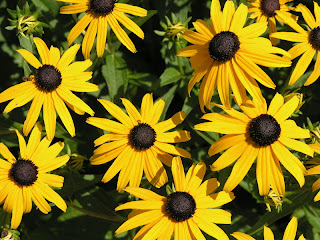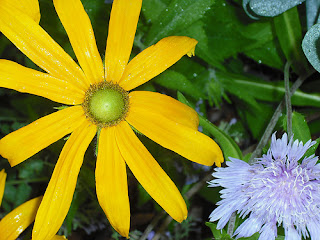 |
| Rudbeckia fulgia var. sulliviani 'Goldsturm', photo by Lukas Riebling |
 |
| Aster x frikartii ‘Mönch’' |
They`re also both extremely generous flowerers, going on and on from about July to October. They coexist well in the garden too, each finding its way into the other's arms.
They flower when blue is at a premium, while yellow is on discount. There must be some reason why there's so many yellow daisies around at that time of the year. I`ve always liked Carol Klein`s comment that if yellow is the colour of spirituality, then rudbeckia fulgida must be the most spiritual of all plants.
Here's another picture I found online while researching this. Those who find 'Goldsturm' and similar rudbeckias too strongly coloured might want to consider this pairing. These green-eyed susans, such as 'Irish Eyes' have a subtler colour, and in zones 7 and 8, will overwinter. I used to try to grow these next to my yellow daylilies and green-flowered kniphofia, but it was too shady, and they would end up flopping over on the grass. You can't help but love something that looks so cheerful and is so willing to flower, though.
 |
| Rudbeckia and Stokes Aster by Melody Lee, Flickr |
All the plants mentioned in this post are extremely easy to grow, and reward you with loads of flowers. So for once a cliche worth repeating?



No comments:
Post a Comment